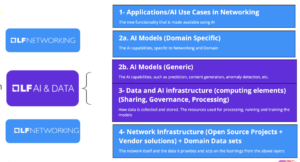Following the initial excitement surrounding large language models (LLMs) and generic AI technologies, we are now entering an era of domain-specific AI. In this post, I will focus on one particular domain: Networking, including Telecommunications.
Why is domain-specific AI becoming a priority for operators and cloud service providers? The answer lies in network data and the challenges of data sharing—or the lack thereof—to train models. These models are poised to support the top five use cases that not only drive new revenue streams but also significantly reduce operational expenses.
What has been successfully used already?
There are a few examples of where AI has been successfully used by Telcos.
- Contact centers are the obvious ones. Pretty much every contact center worldwide now has some form of AI, whether it is for natural language understanding of the query all the way to routing or doing agent assist. The business model is very clear.
- Network operation is another example. There are a large number of deployments where AI is being used for monitoring, alarms, anomaly detections, and those are really helping us to find the very special tickets or very special failures among the millions of failures that basically happen every day.
- Energy consumption is a very clear case for Telco AI. One of the largest spends for Telcos today is energy, whether it’s for the network core or for cell sites, specifically on the RAN. So being able to conserve energy in the RAN network by sending cell sites to sleep is a huge thing.
- Planning for converged wireless and wireline networks can address challenges such as, “I have a billion dollars to spend. I want to pass X number of houses. Find me the best path based on what kind of coverage I want to get.”
- The last one here is cell site configurations. As new cell sites go up, configuring those cell sites, activating those cell sites, and optimizing those cell sites is not a trivial thing.

Opportunities for Gen AI in telco business
In the networking and telecommunications business, there are a number of opportunities we have already figured out, and a large number of telcos today are experimenting with those and deploying those in their field. This could be as simple as being able to draft a postmortem following a network incident within a matter of a few minutes (versus several hours) is now something that’s easily done with Gen AI.
Many Telcos have now built large systems where they have taken all their data and put it together with information into one system that allows them to find the data, normalize data, answer questions about data, integrate data, and more.
Challenges
- Transition to Full AI: Today’s networks implement control and closed loops for policy-driven automation, but they lack learning capabilities. Incorporating learning is the critical final step toward achieving full AI.
- Balancing Data Sharing and Privacy: Networks are rich in valuable data sets, but they also contain sensitive information that cannot be shared directly, yet is essential for training AI models.
- Navigating Vendor-Specific Hype: Overcoming vendor-specific marketing hype is crucial. The industry needs to shift towards a more collaborative, open community, with initiatives like the Linux Foundation Networking (LFN) serving as a collaborative hub.
Several years ago, the industry believed that with distributed cloud, intelligence would primarily reside in the core, handling large, complex tasks like model training, while simpler tasks would be managed at the edge with localized data. However, this perspective is rapidly evolving, even in the context of Generative AI. Today, Generative AI models are being deployed across various locations, not just at the core or edge, and these aren’t small models—they range from 13 billion to 70 billion parameters and beyond. The distribution of intelligence is now largely driven by factors such as data ownership, privacy, security, compliance, and cost. These parameters determine where AI capabilities should reside, and there is now the flexibility to run sophisticated Generative AI models anywhere within this distributed landscape.
As network operators transition from the experimental phase into deploying AI into production, they are starting to reap the benefits of this new technology. At the same time, the pain of dealing with the challenges is becoming clearer. There is a need for sustainable approaches to developing and deploying the network domain-specific AI applications. Open source collaboration is an efficient way to pool industry resources and expertise to create the necessary domain-specific models and other building blocks. Network operators, equipment vendors and system integrators are already collaborating on such initiatives and the open nature of this work makes it easy for the next wave of players to get involved. Contribution to these initiatives is not limited to only lines of code. Quality data, good use cases and user stories are always in high demand.
In the next parts of this blog post series, we will explore in more detail, the learnings from network domain-specific AI application deployment, and what are the best approaches moving forward.